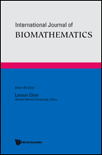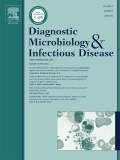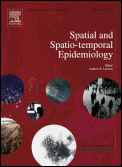
Infectious Disease Modelling
Scope & Guideline
Unleashing the Power of Modeling to Combat Infectious Diseases
Introduction
Aims and Scopes
- Mathematical and Statistical Modeling:
The journal focuses on the development and application of mathematical models to understand and predict the dynamics of infectious diseases. This includes various compartmental models (e.g., SIR, SEIR) and statistical techniques that assess disease spread and control interventions. - Epidemiological Analysis:
Research published in the journal involves in-depth epidemiological analyses that investigate patterns of disease incidence, prevalence, and transmission dynamics across different populations and regions. - Impact Assessment of Interventions:
A significant aspect of the journal's scope is evaluating the effectiveness of public health interventions, such as vaccination campaigns, social distancing measures, and quarantine strategies, using modeling frameworks. - Emerging Infectious Diseases:
The journal addresses modeling challenges associated with emerging and re-emerging infectious diseases, contributing to preparedness and response strategies for global health threats. - Data-Driven Approaches:
There is a strong emphasis on incorporating real-world data into models, enhancing the predictive power and applicability of research findings to inform public health policy and decision-making. - Spatial and Temporal Dynamics:
Research often explores the spatial and temporal aspects of disease transmission, utilizing geographic information systems (GIS) and spatiotemporal modeling techniques to understand how diseases spread across different environments.
Trending and Emerging
- COVID-19 Modeling:
The COVID-19 pandemic has catalyzed an explosion of research focused on modeling its transmission dynamics, vaccination strategies, and public health interventions. This trend showcases the journal's adaptability to urgent global health crises. - Machine Learning and AI Integration:
There is an increasing integration of machine learning and artificial intelligence techniques in modeling infectious diseases, enhancing predictive accuracy and enabling the analysis of large datasets. - Behavioral Dynamics in Disease Spread:
Research is increasingly exploring the impact of human behavior on disease transmission, incorporating social dynamics and compliance with public health measures into modeling frameworks. - Network Theory Applications:
The application of network theory to understand the spread of infectious diseases is gaining traction. Studies are focusing on the role of social networks, mobility patterns, and connectivity in transmission dynamics. - Climate and Environmental Influences:
Emerging studies are examining the effects of climate change and environmental factors on the spread of infectious diseases, highlighting the need for models that consider ecological and climatic variables. - Multi-Pathogen Interactions:
Research is trending towards understanding interactions between multiple pathogens and their collective impact on disease dynamics, reflecting a more holistic approach to infectious disease modeling.
Declining or Waning
- Traditional Compartmental Models:
While compartmental models such as SIR and SEIR have been foundational in infectious disease modeling, there seems to be a waning interest in purely classical approaches. Researchers are increasingly seeking more complex models that incorporate behavioral dynamics, environmental factors, and heterogeneous populations. - Single-Disease Focus:
There is a noticeable decrease in studies focusing solely on single infectious diseases. Instead, there is a growing trend towards integrative models that consider co-infections and the interplay between multiple diseases, reflecting the complexities of real-world epidemiology. - Static Models:
The reliance on static models is declining as researchers prioritize dynamic, time-dependent modeling approaches that can capture the evolving nature of infectious disease transmission and control over time. - Local Data Analysis:
Research that focuses exclusively on localized data without considering broader epidemiological trends or global implications is becoming less common. There is a shift towards studies that incorporate multi-regional or global perspectives.
Similar Journals

IJID Regions
Innovating public health solutions for a healthier tomorrow.IJID Regions is a pioneering open access journal published by Elsevier, focusing on the critical fields of epidemiology, infectious diseases, and public health. Established in 2021, the journal aims to provide a platform for disseminating high-quality, innovative research that addresses pressing health issues and informs evidence-based practices in communities around the globe. With its impact factors reflecting a Tier Q2 and Q3 ranking in various medical subcategories on the Scopus platform, IJID Regions is positioned as a valuable resource for researchers, health professionals, and policy-makers striving to enhance public health outcomes. This journal not only champions open access since its inception, promoting the free flow of information, but also welcomes contributions that shed light on contemporary challenges in environmental and occupational health. Its commitment to fostering dialogue and collaboration in the health sciences is paramount, making it an essential read for those engaged in advancing public health knowledge and initiatives.

Infectious Diseases and Therapy
Empowering discovery in infectious disease therapy.Infectious Diseases and Therapy is a premier scholarly journal published by Springer London Ltd, dedicated to advancing the understanding of infectious diseases through rigorous research and evidence-based therapy. With an esteemed Q1 ranking in both the Infectious Diseases and Microbiology (medical) categories, this journal is a vital resource for researchers, healthcare professionals, and students aiming to stay at the forefront of developments within the field. Launched in 2012, it has embraced an Open Access model, ensuring that groundbreaking studies and critical reviews are accessible to a global audience. Operating from its office in London, the journal encourages the dissemination of innovative therapies and diagnostic methods, fostering collaboration and knowledge sharing among the scientific community. In a landscape where infectious diseases pose significant health challenges, Infectious Diseases and Therapy stands as an essential platform for impactful research that can lead to improved healthcare outcomes worldwide.

Journal of Pathogens
Bridging Knowledge Gaps in Pathogenesis and Public HealthJournal of Pathogens is a premier peer-reviewed journal published by HINDAWI LTD, focusing on the critical field of microbiology, infectious diseases, and the mechanisms of pathogen interactions with hosts. Since its inception in 2011 as an Open Access journal, it has aimed to provide a platform for high-quality research articles, reviews, and case studies that enhance our understanding of pathogenesis and advance the science of disease control. With its commitment to making research freely accessible, the journal attracts a global audience of researchers, professionals, and graduate students keen on exploring innovative findings and applications in the study of pathogens. While the journal does not currently have an established H-index or category quartiles, its relevance and importance in the field continue to grow as it seeks to bridge knowledge gaps and facilitate impactful discussions in infectious disease research. Located at Adam House, 3rd Floor, 1 Fitzroy Square, London W1T 5HF, England, the Journal of Pathogens invites submissions that contribute to the ever-evolving landscape of pathogen research and public health.

BULLETIN OF MATHEMATICAL BIOLOGY
Exploring the Mathematical Foundations of LifeBulletin of Mathematical Biology, published by Springer, is a premier journal dedicated to advancing the field of mathematical biology. With an ISSN of 0092-8240 and an E-ISSN of 1522-9602, this journal has been at the forefront of interdisciplinary research since its inception in 1973, continuing to deliver high-quality contributions through 2024. Operating without an open-access model, the journal maintains robust academic rigor, reflected in its category quartiles for 2023, which positions it in Q1 and Q2 across several relevant fields, including Agricultural and Biological Sciences, Biochemistry, Genetics, and Mathematics, among others. Its impressive Scopus ranks further underscore its significance, placing it in the top tier of journals in general mathematics and agricultural sciences. Researchers, professionals, and students looking to deepen their understanding and contribute to the evolving landscape of mathematical biology will find this journal an essential resource for contemporary studies and advancements in the field.

Epidemiology and Health
Empowering public health insights for a healthier tomorrow.Welcome to Epidemiology and Health, a premier open-access journal dedicated to advancing knowledge in the fields of epidemiology and public health. Published by the Korean Society of Epidemiology since 1979, this journal serves as a vital platform for researchers, professionals, and students alike, promoting innovative research and robust discussion surrounding public health issues. Based in South Korea, it boasts a commendable Q2 ranking in the categories of Epidemiology, Public Health, and Environmental and Occupational Health, reflecting its significant contribution to the scientific community. With its current impact factor ranking it favorably among peers—#124 out of 665 in Public Health and #40 out of 148 in Epidemiology—Epidemiology and Health continues to uphold its mission of disseminating high-quality, peer-reviewed research. The journal's commitment to open access ensures that vital epidemiological insights reach a broad audience, supporting the collective goal of improving global health outcomes. Engage with pioneering studies and emerging trends within these critical fields, as we work towards a healthier future.

China CDC Weekly
Connecting scholars and practitioners for a healthier tomorrow.China CDC Weekly is an esteemed academic journal published by the Chinese Center for Disease Control and Prevention, dedicated to disseminating critical research in the fields of epidemiology, infectious diseases, and public health. Since its inception in 2019, the journal has rapidly established itself as a key resource for scholars, professionals, and students, achieving notable rankings, including Q2 in Epidemiology and Infectious Diseases, and Q1 in Public Health, Environmental, and Occupational Health for 2023. With an emphasis on the latest advancements and data-driven insights, China CDC Weekly offers a platform for researchers to contribute to the vital discourse surrounding health policies, disease control, and public safety in a rapidly evolving global landscape. As an open-access journal, it ensures widespread availability and visibility of research findings, reflecting its commitment to advancing public health knowledge in China and beyond. The conference years from 2019 to 2024 further highlight its responsiveness to emerging health challenges and trends, positioning the journal as a preeminent publication for interdisciplinary collaboration and innovation.

International Journal of Biomathematics
Exploring the Nexus of Mathematics and BiologyInternational Journal of Biomathematics is a premier scholarly publication dedicated to the intersection of mathematics and biological sciences. Published by World Scientific Publishing Co Pte Ltd in Singapore, this journal serves as a vital resource for researchers and practitioners seeking to explore the quantitative modeling of biological systems. Recognized for its significant contributions to Applied Mathematics and Modeling and Simulation, it achieved a commendable Q2 ranking in both categories in 2023, reflecting its impact within the academic community. The journal, with ISSN 1793-5245 and E-ISSN 1793-7159, promotes open access to facilitate the dissemination of knowledge and encourages submissions that advance the theoretical and practical applications of biomathematics. With a commitment to fostering interdisciplinary collaboration, the International Journal of Biomathematics plays an essential role in shaping the future of research in mathematical biology.

Top
Innovating Solutions Through Rigorous Academic InquiryTop is a prestigious academic journal published by Springer, dedicated to advancing research in the fields of Discrete Mathematics, Combinatorics, Information Systems and Management, Management Science and Operations Research, Modeling and Simulation, and Statistics and Probability. With its ISSN 1134-5764 and E-ISSN 1863-8279, this journal holds a commendable Q2 ranking across multiple categories as of 2023, evidencing its strong impact within the academic community. The journal has experienced a significant convergence of knowledge from the years 1993 to 1996, 2003, and is active until 2024, showcasing its long-standing commitment to scholarly excellence. Although it does not currently offer Open Access options, its quality is reflected in Scopus rankings, notably being in the 97th percentile for Discrete Mathematics and Combinatorics. Researchers, professionals, and students in these domains are encouraged to engage with Top as it continues to facilitate groundbreaking insights and foster collaboration among various disciplines.

DIAGNOSTIC MICROBIOLOGY AND INFECTIOUS DISEASE
Connecting Science and Practice in MicrobiologyDIAGNOSTIC MICROBIOLOGY AND INFECTIOUS DISEASE, published by Elsevier Science Inc, is a leading journal in the fields of Infectious Diseases, Microbiology, and Medicine. Since its inception in 1983, this esteemed journal has consistently provided a platform for original research and comprehensive reviews that advance the understanding of diagnostic microbiology and its implications for infectious diseases. With an impressive impact factor placing it in the Q2 category in multiple relevant fields as of 2023, it stands out with Scopus rankings reinforcing its significance in academia, ranking #136 out of 344 in Infectious Diseases and #64 out of 140 in Medical Microbiology. This journal is essential for researchers, healthcare professionals, and students who seek to stay abreast of the latest developments and trends in infectious diagnostics. DIAGNOSTIC MICROBIOLOGY AND INFECTIOUS DISEASE is committed to fostering excellence in research quality and academic rigor, ensuring accessibility to vital knowledge for addressing some of the most pressing health challenges of our time.

Spatial and Spatio-Temporal Epidemiology
Bridging Disciplines for Better Public Health SolutionsSpatial and Spatio-Temporal Epidemiology is a premier journal dedicated to advancing the understanding of spatial patterns and temporal dynamics in epidemiological research. Published by ELSEVIER SCI LTD in the United Kingdom, this journal utilizes a robust interdisciplinary approach, blending methodologies from epidemiology, geography, and environmental science. With an impressive impact factor and categorized in the top quartiles for its fields—Q2 in Epidemiology and Q1 in Geography, Planning and Development (2023)—this journal excels in providing high-quality insights relevant to both academic researchers and public health professionals. The journal supports open access options, enhancing the dissemination and impact of scholarly articles. Since its inception in 2009, Spatial and Spatio-Temporal Epidemiology has published a myriad of studies that contribute significantly to understanding the geographical and temporal aspects of diseases, thereby serving as a crucial resource for anyone invested in improving public health outcomes and addressing infectious diseases globally.